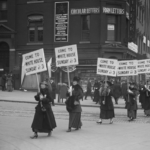The history of women’s rights is a complex and multifaceted journey that spans centuries and continents, marked by significant struggles and milestones toward equality.
Early Advocacy (19th Century)
The modern women’s rights movement began in the late 19th century, primarily in the United States and Europe. It was during this period that women began organizing for their rights, particularly in the areas of education, suffrage, and labor. The Seneca Falls Convention in 1848, led by figures like Elizabeth Cady Stanton and Lucretia Mott, is often cited as the formal beginning of the women’s rights movement in the U.S. Here, the Declaration of Sentiments was adopted, outlining grievances and demands for women’s suffrage and equality.
The Suffrage Movement (Late 19th to Early 20th Century)
The suffrage movement gained momentum in the late 19th and early 20th centuries. In the U.S., activists like Susan B. Anthony and Alice Paul fought tirelessly for women’s right to vote. Their efforts culminated in the passage of the 19th Amendment in 1920, granting women the right to vote. Meanwhile, in the UK, the suffragette movement, led by Emmeline Pankhurst, employed both peaceful protests and militant tactics to secure voting rights for women.
Post-War Progress (1940s-1960s)
After World War II, women returned to traditional roles, but the 1960s sparked a new wave of feminism. The publication of Betty Friedan’s “The Feminine Mystique” in 1963 challenged the societal norms of womanhood and ignited discussions about women’s roles in society. The formation of groups like the National Organization for Women (NOW) in 1966 marked a more organized approach to advocating for women’s rights, focusing on issues like equal pay, reproductive rights, and workplace equality.
Legal Advances (1970s-1990s)
The 1970s saw significant legal advancements for women in many countries. In the U.S., Title IX was enacted in 1972, prohibiting sex-based discrimination in education. The Roe v. Wade Supreme Court decision in 1973 recognized a woman’s right to choose, a landmark moment for reproductive rights. Globally, the 1979 Convention on the Elimination of All Forms of Discrimination Against Women (CEDAW) was adopted by the United Nations, promoting gender equality worldwide.
Contemporary Issues (2000s-Present)
Today, the fight for women’s rights continues, focusing on issues like gender-based violence, reproductive rights, workplace discrimination, and representation in politics and business. Movements like MeToo and Time’s Up have brought attention to sexual harassment and assault, empowering women to speak out against injustices.
The history of women’s rights is a testament to the resilience and determination of countless women who have fought for equality. While significant progress has been made, the journey toward full gender equality is ongoing, requiring continued advocacy and action across the globe. As we reflect on this history, it is crucial to recognize the importance of solidarity and the collective efforts needed to advance women’s rights for future generations.
Taylor Moore
Article Excerpt : excerpt_custom_field : The history of women's rights is a complex and multifaceted journey that spans centuries and ...


